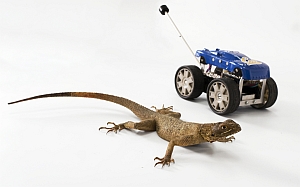A team of biologists and engineers at University of California, Berkeley have documented the way lizards manage to leap successfully even when they slip and stumble, and applied that capability to robots. Berkeley professor of integrative biology Robert Full and colleagues, including graduate and undergraduate students, describe their findings in the 5 January online issue of the journal Nature (paid subscription required). The first author, engineering grad student Thomas Libby, will also report the results on 7 January at a meeting of the Society for Integrative and Comparative Biology in Charleston, South Carolina.
Full’s team found that lizards swing their tails upward to prevent from pitching head-over-heels into a rock. The researchers also found, however, that it takes more than a tail to keep a jumping lizard or robot stable. Lizards and robots must also adjust the angle of their tails to an exact position to remain upright.
The research tested a 40-year-old hypothesis that theropod dinosaurs — the two-legged ancestors of modern birds — used their tails as stabilizers while running or dodging obstacles or predators. In Full’s teaching laboratory, students noticed that lizards recovered after slipping during a leap, and proposed a study of stumbling to test the value of that tail.
Participants in the lab, part of Berkeley’s Center for Interdisciplinary Bio-inspiration in Education and Research (CiBER), used high-speed videography and motion capture to record ways a red-headed African Agama lizard handled leaps from a platform with different degrees of traction, from slippery to easily-gripped. When friction on the platform was reduced, lizards slipped, causing their bodies to potentially spin out of control.
By systematically capturing the actions of the lizard using its tail to counteract the spin and gain control, the researchers were able to create a mathematical model for these actions. They then applied these algorithms to a Tailbot, a robotic toy car with a motorized tail and a small gyroscope to sense body position.
Using just the tail, and no feedback about body position from sensors, the Tailbot took a nose-dive when driven off a ramp. When body position was sensed and fed back to the tail motor, however, the Tailbot was able to stabilize its body in midair. The tail, controlled by feedback, redirected the angular momentum of the body into the tail’s swing, much as it happens with jumping lizards. The following video shows the Agama lizard and Tailbot in normal and slow-motion (Courtesy of CiBER/UC Berkeley).
“We showed for the first time that lizards swing their tail up or down to counteract the rotation of their body, keeping them stable,” says Full. “Inspiration from lizard tails will likely lead to far more agile search-and-rescue robots.”
The work was funded by the National Science Foundation’s Integrative Graduate Education and Research Traineeship (IGERT) program, and the Micro Autonomous Systems and Technology consortium — supported in part by the U.S. Army Research Laboratory — that studies autonomous sensing robots.
Read more: University Develops, Licenses Autonomous Robotics Technology
* * *


 RSS - Posts
RSS - Posts
You must be logged in to post a comment.